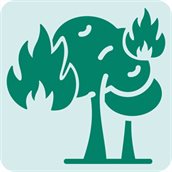Policies & regulations for wildfires
Currently, the Netherlands does not have a national action framework to mitigate the consequences of wildfires. To act on this, the Council of Fire Chiefs and Safety Region Directors (in Dutch: De Raad van Commandanten en Directeuren Veiligheidsregio’s) of the Dutch fire brigade set up a taskforce on wildfire management in 2022. This taskforce published an outlook on wildfire management until 2050 (PDF), which details on risk management, repression and knowledge development.
In the outlook, the authors recommend basing the action plan on the principle of multilayer safety (meerlaagsveiligheid in Dutch), where different types of measures in complement and reinforce each other. This approach is also used in flood risk management and can include th:
- Layer 0: Measures that increase public awareness of wildfire risk.
- Layer 1: Measures that reduce the susceptibility for the occurrence of wildfires.
- Layer 2: Measures that reduce the impact of a wildfire, for example by adapting vegetation and managing drought.
- Layer 3: Measures that improve incident response and crisis management in a wildfire.
- Layer 4: Measures focused on sustainable recovery following a wildfire.
Apart from the developments around a national action framework on wildfires, the Netherlands published its National Crisis Plan for Wildfires in 2024. This plan forms the foundation for how different crisis partners cooperate during a wildfire and offers guidance for the crisis and action plans of the organisations involved.
As part of this framework, a new expertise centre on wildfires will be established. Among its responsibilities, the centre will monitor and report on the number of wildfires occurring in the Netherlands. In 2025, a specific section of the national crisis plan focusing on risk and crisis communication during wildfires was released. It outlines agreements on procedures, structures, coordination, knowledge exchange, and communication. This addition helps clarify roles and responsibilities further. After additional crisis plan measures were left unimplemented, the Dutch House of Representatives passed a motion (PDF) in July 2025 to take stronger initiative in developing legislation to prevent and mitigate wildfires.
Relevant actors
Apart from the Dutch fire brigade, other relevant governmental organisations for wildfires are the Dutch Institute for Public Safety (NIPV) and the State Forest Management (in Dutch: Staatsbosbeheer). Local governments, health care services, the police, water authorities, and other stakeholders also play a vital role. Successfully putting the multilayer safety principle into practice requires close cooperation between all actors, combining the individual responsibilities.
For wildfires, NIPV focusses on knowledge development, innovation, capacity building, and coordination of safety regions, for governmental organisations and international partners. NIPV also releases annual reports on the wildfires of the previous year.
The State Forest Management is a Dutch governmental organisation for forestry and management of nature reserves and national parks. With over 250,000 hectares of land in the Netherlands, they have a major role to prevent and control wildfires. In terms of prevention they:
- Ensure nature reserves and national parks are accessible for fire brigade vehicles.
- Variation of tree and plant species to prevent rapid spreading of wildfires. For example, conifers are more flammable than deciduous trees.
- Grazing by sheep and cows to prevent the growth of flammable grass species.

